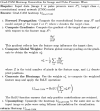A non-invasive prediction model for coronary artery stenosis severity based on multimodal data
- PMID: 40529992
- PMCID: PMC12171179
- DOI: 10.3389/fphys.2025.1592593
A non-invasive prediction model for coronary artery stenosis severity based on multimodal data
Abstract
Introduction: Coronary artery disease (CAD) diagnosis currently relies on invasive coronary angiography for stenosis severity assessment, carrying inherent procedural risks. This study develops a transformer-based multimodal prediction model to provide a clinically reliable non-invasive alternative. By integrating heterogeneous biomarkers including facial morphometrics, cardiovascular waveforms and biochemical indicators, we aim to establish an interpretable framework for precision risk stratification.
Methods: The study utilized a transformer-based architecture integrated with residual modules and adaptive weighting mechanisms. Multimodal data, including facial features, lip and tongue images, pulse and pressure wave amplitudes, and laboratory indicators, were collected from 488 CAD patients. These data were processed and analyzed to predict the severity of coronary artery stenosis. The model's performance was evaluated using both internal and external validation datasets.
Results: The proposed model demonstrated high predictive accuracy, achieving over 90% accuracy in assessing coronary artery stenosis risk on the training dataset. External validation on real-world data further confirmed the model's robustness, with an accuracy of 85% on the validation set. The integration of multimodal data and advanced architectural components significantly enhanced the model's performance.
Conclusion: This study developed a non-invasive, transformer-based multimodal prediction model for assessing coronary artery stenosis severity. By combining diverse data sources and advanced machine learning techniques, the model offers a clinically viable alternative to invasive diagnostic methods. The results highlight the potential of multimodal data integration in improving CAD diagnosis and patient care.
Keywords: cardiovascular risk assessment; coronary artery disease; deep learning approaches; machine learning for disease risk stratification; multimodal prediction.
Copyright © 2025 Zhang, Xu, Tu, Jiang, Wang and Xu.
Conflict of interest statement
The authors declare that the research was conducted in the absence of any commercial or financial relationships that could be construed as a potential conflict of interest.
Figures













Similar articles
-
Enhanced stroke risk prediction in hypertensive patients through deep learning integration of imaging and clinical data.BMC Med Inform Decis Mak. 2025 Jul 31;25(1):285. doi: 10.1186/s12911-025-03120-6. BMC Med Inform Decis Mak. 2025. PMID: 40745655 Free PMC article.
-
MRI-based multimodal AI model enables prediction of recurrence risk and adjuvant therapy in breast cancer.Pharmacol Res. 2025 Jun;216:107765. doi: 10.1016/j.phrs.2025.107765. Epub 2025 May 7. Pharmacol Res. 2025. PMID: 40345352
-
Deep learning model for coronary artery segmentation and quantitative stenosis detection in angiographic images.Med Phys. 2025 Jul;52(7):e17970. doi: 10.1002/mp.17970. Med Phys. 2025. PMID: 40665573
-
Defining disease severity in atopic dermatitis and psoriasis for the application to biomarker research: an interdisciplinary perspective.Br J Dermatol. 2024 Jun 20;191(1):14-23. doi: 10.1093/bjd/ljae080. Br J Dermatol. 2024. PMID: 38419411 Free PMC article. Review.
-
Transformers for Neuroimage Segmentation: Scoping Review.J Med Internet Res. 2025 Jan 29;27:e57723. doi: 10.2196/57723. J Med Internet Res. 2025. PMID: 39879621 Free PMC article.
References
-
- Amsterdam E. A., Wenger N. K., Brindis R. G., Casey D. E., Ganiats T. G., Holmes D. R., et al. (2014). 2014 AHA/ACC guideline for the management of patients with non-ST-elevation acute coronary syndromes: executive summary: a report of the American College of Cardiology/American Heart Association Task Force on Practice Guidelines. Circulation 130 (25), 2354–2394. 10.1161/CIR.0000000000000133 - DOI - PubMed
-
- Di Angelantonio E., Kaptoge S., Pennells L., De Bacquer D., Cooney M. T., Kavousi M., et al. (2019). World health organization cardiovascular disease risk charts: revised models to estimate risk in 21 global regions. Lancet Glob. Health 7 (10), E1332–E1345. 10.1016/S2214-109X(19)30318-3 - DOI - PMC - PubMed
-
- Dosovitskiy A., Beyer L., Kolesnikov A., Weissenborn D., Zhai X., Unterthiner T., et al. (2020). An image is worth 16x16 words: transformers for image recognition at scale. arXiv preprint. 10.48550/arXiv.2010.11929 - DOI
LinkOut - more resources
Full Text Sources
Miscellaneous

